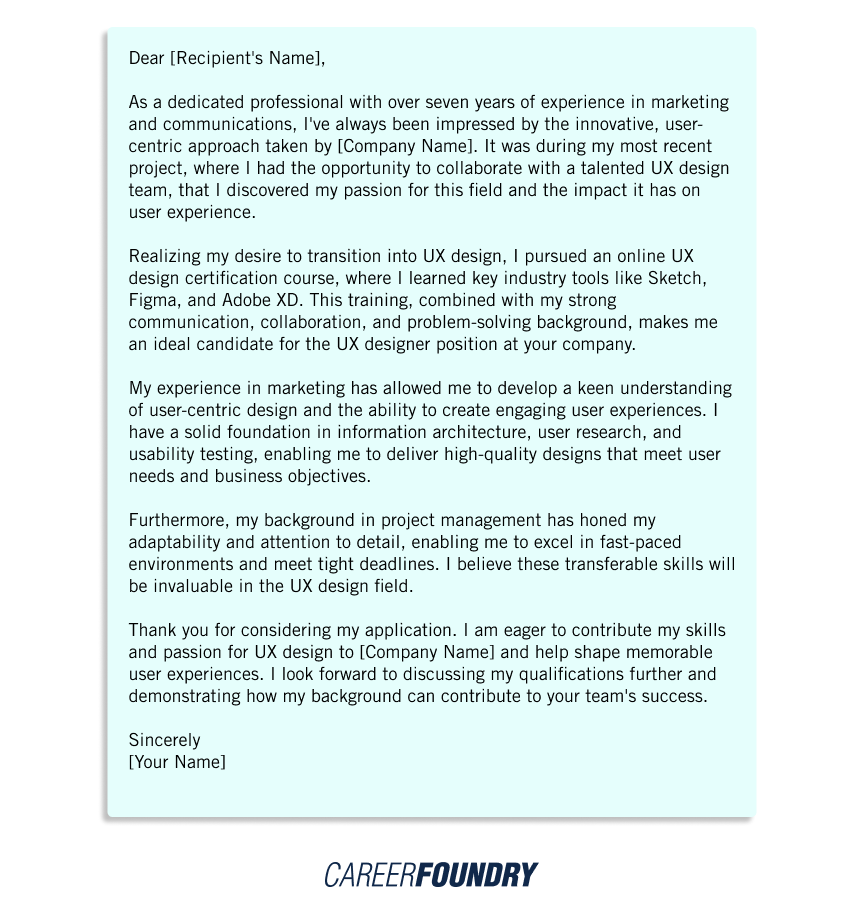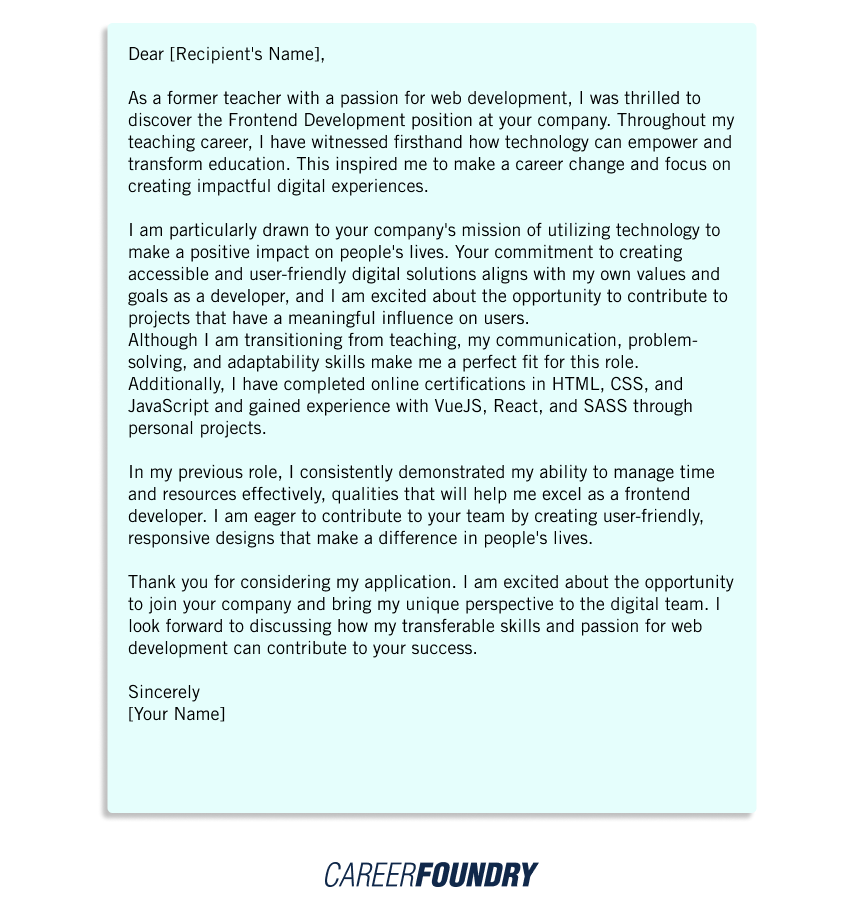Switching careers can feel like embarking on a journey into uncharted territory—this is particularly true in the tech industry, where a career change often means navigating an entirely different set of digital tools, work processes, responsibilities, and skills.
You may have prepared yourself for the challenges ahead, furthered your education, and even identified job postings you believe to be a great fit. But without an excellent career change cover letter, your new professional journey could be stalled before it even begins!
Hiring managers only look at resumes for seven seconds before deciding whether to proceed with the application. So, your cover letter has to make an immediate and lasting impression.
To help you land the job you’ve been dreaming of, we’ve put together this comprehensive guide on career change cover letters.
Here are the topics we’ll explore—feel free to skip around to the sections that interest you most:
- What makes it a career change cover letter?
- How to write a career change cover letter in 8 steps
- Career change cover letters example
- Key takeaways
1. What makes it a career change cover letter?
Before we look at the format and structure of the cover letter, let’s clarify something: it may seem obvious, but what distinguishes traditional cover letters from those written by career changers?
The key difference lies in the way you present yourself and the story you tell. A career change cover letter must demonstrate three main things:
- Your understanding of the job and industry,
- your existing skills and experience, and
- how those can be applied to the new position.
This can be done in several ways, but the most effective cover letters strike a balance between emphasizing transferable skills, demonstrating adaptability, and highlighting your motivation for the career transition.
Unlike traditional cover letters, they can also address potential concerns about your experience, showcasing your ability to transcend the boundaries of one professional field and excel in another.
2. How to write a career change cover letter in 8 steps
Writing winning cover letters is an art that requires practice, and career-change-specific cover letters are even trickier to tackle. But thankfully, you can follow a few best practices to create a compelling document that will make it easier for potential employers to imagine you in the new role.
This step-by-step guide will walk you through the process of writing an effective cover letter for your career switch, from the opening line to the closing paragraph. So, grab a pen or open up your favorite word processor and write that first draft using the following tips:
1. Address the right person
To avoid using the impersonal salutation, “Dear hiring manager,” take the time to research who will be reading your cover letter.
If the job ad doesn’t include a name, try searching for the company’s website or LinkedIn page and go to the employees’ section to track down the right person and job title. For example, if you’re applying for a UX designer role, search for “Director of UX Design,” “Creative Director,” or similar.
2. Introduce yourself with a hook
Begin your cover letter with an engaging opening that captures the reader’s attention.
This could be a statement of your intent, a specific project you’ve recently completed, or a personal connection to the industry that demonstrates your passion and motivation for the career switch. This will set you apart from other candidates and create a memorable first impression.
3. Explain why you’re changing careers
To address your career change head-on, provide a clear rationale for the shift by sharing your personal career change story. For example, you could highlight your enthusiasm for the new field, noting what attracted you to it and any relevant experiences or interests supporting your decision.
Then, use the power of personal branding to infuse the letter with your unique voice, personality, and vision, focusing on the value you can bring to the new sector. This transparency shows employers you’ve thoughtfully considered the move.
4. Demonstrate understanding of the company
Demonstrate your genuine interest in the organization by showing that you’ve thoroughly researched the company. You can achieve this by discussing its mission statement, values, and recent accomplishments.
Align your skills, background, and career goals with the company’s objectives to showcase your potential fit within its corporate culture. Doing so will convey your enthusiasm for the role and the organization, increasing your chances of standing out as a suitable candidate.
5. Detail why you’re a great match
A personalized cover letter should also explain why you’re a strong candidate for the position in question. This means identifying the unique qualities that set you apart from other candidates, whether that’s your adaptability, problem-solving abilities, or valuable soft skills that can be applied across various industries.
Use real-world examples to demonstrate how your skills and past experiences align with the job requirements, and mention how these traits can benefit the company in the long run.
6. Showcase transferable skills
One of the key objectives of your career change cover letter is to demonstrate your value to potential employers in your new field. To do this effectively, pinpoint the skills you’ve acquired in your previous career that are transferable to the new role.
Use specific examples to illustrate how you’ve applied these skills in different contexts and how they are relevant to your new position. By showcasing your relevant skills and experience, you can effectively demonstrate to employers that you have what it takes to excel in your new career path.
7. Mention relevant professional development
List any skills and knowledge you’ve gained through relevant courses, certifications, or training to showcase your commitment to learning and willingness to invest in your career transition.
This will set you apart from other aspiring career changers, prove your enthusiasm for the role and help paint a picture of what you can bring to the new position. Doing due diligence upfront will make it easier for potential employers to imagine you in the new role and increase the chances of securing an interview.
8. Conclude on a positive note
When concluding your career change cover letter, it’s essential to end it enthusiastically. For example, name one way you can add value to the company and link it to your overall career vision.
Finally, thank the hiring manager for considering your application and express your excitement about joining the team. Doing so will show you’re committed to the role and motivated to make a success of your career transition.
3. Career change cover letters example
Want to see cover letter examples that nail these key points? Check out these two samples, written specifically for career changers in the tech sector. Best practice for the email subject line? Put the job title from the job ad along with your full name.
Career change cover letter example: UX design

Career change cover letter: Frontend development

4. Key takeaways
Writing a convincing cover letter that highlights your skills for a role you’re hoping to transition into is an essential step in the job application process.
A thoughtfully crafted career change cover letter can be the reason why employers take a second look at your resume, despite your limited experience in the new field.
In this article, we’ve gone through the basics of what makes a career change cover letter unique and how to write one tailored to your experience and goals. We’ve also looked at practical tips for structuring your letter and provided examples for your inspiration.
We hope this guide will give you the confidence to write a standout cover letter and put your best foot forward when applying for jobs.
Looking for more tech-specific application support? Check out our practical guide to crafting the best tech resume, complete with valuable tips and real-world examples.
For further education support on your career change journey, try our free tech short courses, or speak directly with a program advisor.
With the help of expert instructors, personalized feedback, and a wealth of learning resources, you’ll soon be ready to tackle even the most complex challenges future employers might throw at you.
Enjoyed this blog post? We think you’ll like these, too:
